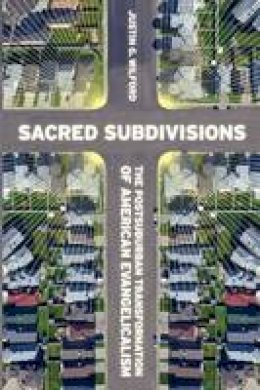
Stock image for illustration purposes only - book cover, edition or condition may vary.
Sacred Subdivisions: The Postsuburban Transformation of American Evangelicalism
Justin Wilford
FREE Delivery in Ireland
Description for Sacred Subdivisions: The Postsuburban Transformation of American Evangelicalism
Paperback. Explains how evangelical megachurches thrive by transforming mundane secular spaces into arenas of religious significance Num Pages: 233 pages, 7 tables, 12 figures, 7 halftones. BIC Classification: 1KBB; HRCC99. Category: (P) Professional & Vocational. Dimension: 228 x 155 x 17. Weight in Grams: 372.
In an era where church attendance has reached an all-time low, recent polling has shown that Americans are becoming less formally religious and more promiscuous in their religious commitments. Within both mainline and evangelical Christianity in America, it is common to hear of secularizing pressures and increasing competition from nonreligious sources. Yet there is a kind of religious institution that has enjoyed great popularity over the past thirty years: the evangelical megachurch. Evangelical megachurches not only ... Read more continue to grow in number, but also in cultural, political, and economic influence. To appreciate their appeal is to understand not only how they are innovating, but more crucially, where their innovation is taking place. In this groundbreaking and interdisciplinary study, Justin G. Wilford argues that the success of the megachurch is hinged upon its use of space: its location on the postsuburban fringe of large cities, its fragmented, dispersed structure, and its focus on individualized spaces of intimacy such as small group meetings in homes, which help to interpret suburban life as religiously meaningful and create a sense of belonging. Based on original fieldwork at Rick Warren's Saddleback Church, one of the largest and most influential megachurches in America, Sacred Subdivisions explains how evangelical megachurches thrive by transforming mundane secular spaces into arenas of religious significance. Show Less
Product Details
Publisher
New York University Press United States
Place of Publication
New York, United States
Shipping Time
Usually ships in 7 to 11 working days
About Justin Wilford
Justin G. Wilford is Research Associate in the Center for Religion and Civic Culture at the University of Southern California.
Reviews for Sacred Subdivisions: The Postsuburban Transformation of American Evangelicalism
Wilford's holistic reading of the evangelical landscape provides a new understanding of how megachurches have swept across suburban America. -Deborah Justice,Marginalia This book would be an excellent choice for graduate seminars and advanced undergraduate classes on religion or urban studies, in part because of its clear and multidisciplinary discussion of secularization and modernization debates. -Sacred Subdivisions Wilford ... Read morewrites clearly and makes complex issues quite accessible. Anthropologists of Christianity and contemporary American cities, especially, stand to benefit from the book's major insights about the deep entanglements of evangelical religion, late modernity, and the cultural geography of postsuburbia. -James S. Bielo,Anthropological Quarterly Sacred Subdivisions is the first full-length treatment of the American megachurch phenomenon by a geographer, providing a compelling analysis of how the fragmented 'post-suburban' context shapes and challenges these large congregations. Author Justin G Wilford notes that of the largest 50 non-denominational (a characteristic that he sees as essential to these congregations) megachurches, all but six are situated on the residential fringe of metropolitan areas - a percentage that only increased in the last decade... [Sacred Subdivisions] richly documents, the high degree of adaptability of megachurches (and the fact that there are highly successful ones located in major cities) suggests that they may be able to survive and thrive in landscapes far different than the ones in which they were planted. -Richard Cimino,Urban Studies This is a brilliant analysis of why postsuburban megachurches, such as Rick Warren's Saddleback Community Church, are growing. Justin Wilford utilizes his training as a geographer to understand the fit between suburban sprawl and postdenominational churches. These liturgically lithe, symbolically flexible, and spatially supple churches are attractive to people living fragmented lives because they mirror the choices available to residents of secular suburbia, while at the same time supplying community, therapeutic insight, and biblically-informed language of how to live a purposeful life. -Donald E. Miller, Center for Religion and Civic Culture, University of Southern California [T]his is a very readable addition to the literature on megachurches and expands our understanding of their influences in American religious life. -Stephen Ellingson,Nova Religio Sacred Subdivisions offers a much needed assessment of the attractiveness of megachurches within the postsuburban milieu. Wilford skillfully explains how places like Saddleback remain so attractive to those living in an era of socio-spatial fragmentation. -Mark T. Mulder, Religious Research Association Review The author, using the literature and theoretical work in cultural geography, makes a strong case that Postdenominational Evangelical (PE) Megachurches must be analyzed not simply as more effective marketers of religious goods, but as innovators in a fragmented and post-suburban social and spatial environment that dictates a new form of meaning-making relative to religion. As a reviewer (who is not a geographer), I found the text fascinating study. Wilford's grasp of the literature in sociology of religion and in his own discipline is impressive. His willingness to push against old and new paradigms and prejudices was bracing. -James K. Wellman Jr.,University of Washington Wilford does a great service by highlighting the role of the material and spatial configuration of large evangelical congregations and has simultaneously brought secularization debates into geography and important spatial theory into the sociology of religion. -Peter Schuurman,Oxford University Press [Sacred Subdivisions] richly documents, the high degree of adaptability of megachurches (and the fact that there are highly successful ones located in major cities) suggests that they may be able to survive and thrive in landscapes far different than the ones in which they were planted. -Urban Studies Journal Show Less

